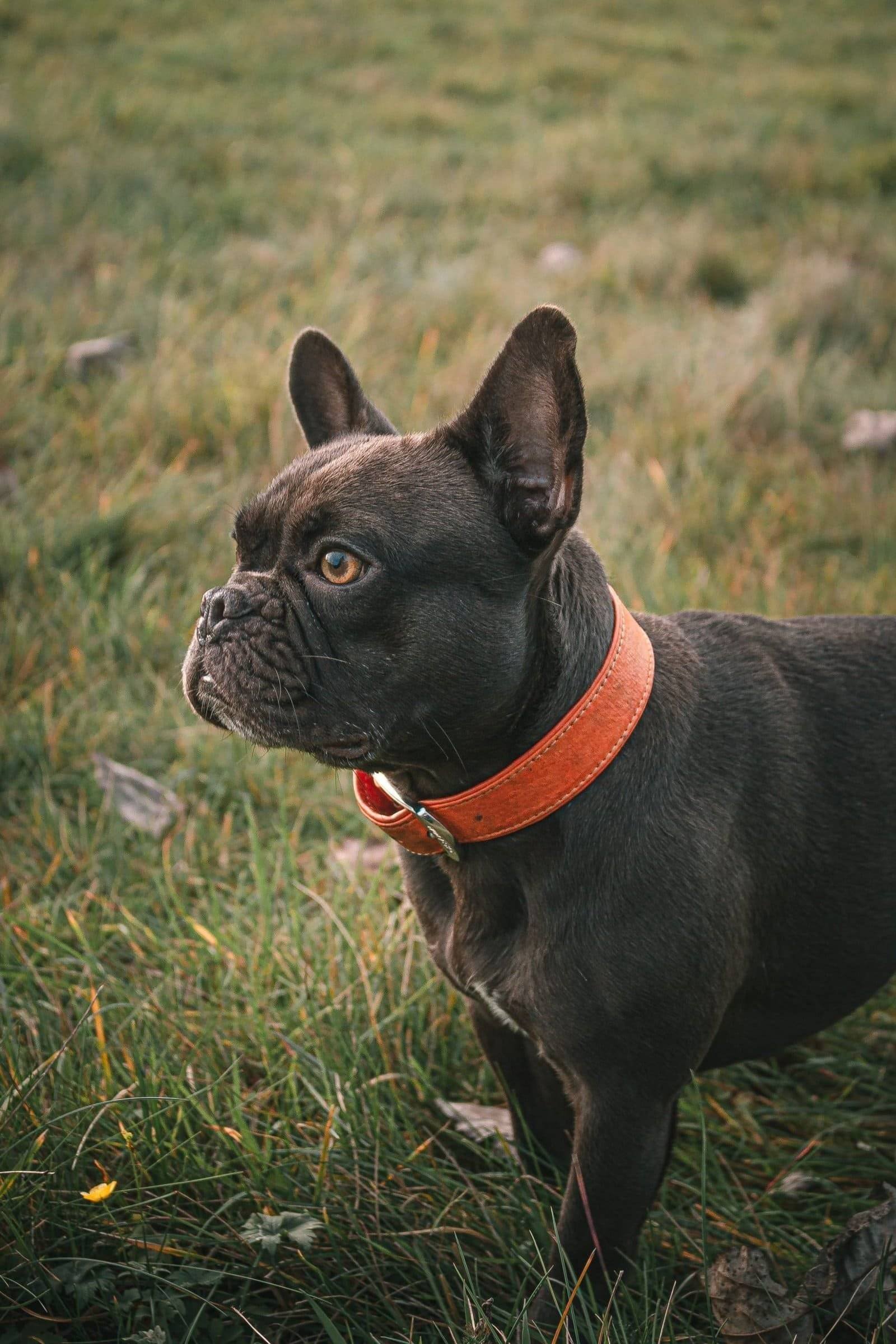Why a French Bulldog?
Because you are investigating this site, you may already know a great deal about the French Bulldog and know that this is the dog breed for you. Others may be interested in a Frenchie, but do not feel informed enough to make a decision. Either way, hopefully, you will find the information we provide in this section (as well in other sections) interesting and informative, as well as come to an understanding of our love and concern for this wonderful breed, as we give you some of our “unbiased” observations, knowledge, and experience with the French Bulldog. We recommend you also reference the websites of the AKC and the French Bulldog Club of America before making a final decision, to ensure you are a good candidate to own one (or more) of these wonderful companions.ibus leo.
- Home
- Why a French Bulldog?


Are French Bulldogs for everyone?
We are not the only members of our family who love French Bulldogs – our husbands, as well as all of the kids, love them just as much. However, we recognize that Frenchies are not going to be for everyone. First of all, French Bulldogs are not cheap, especially the rare blue, chocolate, and lilac brindles and pieds, and most especially the even more rare pure blacks, blues, chocolates, and lilacs and the pure blacks, blues, chocolates, and lilacs with tan points (and pieds in these gorgeous colors). We have a fortune tied up in our family of Frenchies, and there is a huge time commitment and expense that goes into breeding Frenchies. They almost always have to be artificially inseminated, they have relatively small litters, and the females require C-sections, which all contribute to their relatively high price. However, if color is not an issue, the standard colors of brindle, fawn, sable, cream, and pieds in these colors are relatively affordable. Frenchie owners will almost invariably tell you that their healthy Frenchie is well worth the price.
If you like to take your dog for walks or with you to run errands, be prepared for a lot of attention! Because of the temperament, beauty, body structure, and relatively scarcity of these great little dogs (I initially wrote this several years ago – the Frenchie has become the most popular breed in the U.S. as of 2022, but this has brought a lot of unscrupulous and inexperienced breeders into the market), you will likely be inundated with admirers wherever you go. It’s not just everybody who has one of these for a companion. It’s hard to believe how many people come up to us when we take any of our Frenchies out in public! Adults, as well as kids, want to pet them, know what kind of dog they are, and where they can get one. Even veterinary clinics are in awe when we bring in our Frenchies (and they are used to seeing all different kinds of breeds on a daily basis).
If you are looking for a combination pet/sporting dog, a Frenchie might not be the dog for you. First of all, Frenchies do not have great noses (probably because their noses are so short), generally can’t swim, do not have great stamina, don’t run all that fast, and don’t jump all that high. If you’re looking for a sporting dog, we would recommend getting a Lab or a Golden Retriever, based on our experiences. They are great dogs who love people and are also good in the field. On the other hand, Frenchies are as happy as they can be with a short walk and backyard playtime, although some are happy to take jogs with you if that is your thing :-). If you live in an apartment, Frenchies adapt extremely well due to the fact that they do not require a lot of space nor excessive exercise.
Also, if you are looking for a full-time outside dog – keep looking. French Bulldogs do not tolerate temperature extremes well and should not be kept outside for extended periods of time during very hot or extremely cold weather. Fortunately, French Bulldogs are great inside dogs that are very content to lay on a doggie cushion and make themselves totally at-home.
However, all of our dogs do love to spend time outside – if they get too warm on very hot days, they have the sense to find some shade or splash around in the kiddy pool (with only 3 or 4 inches of water in it). On extremely cold days, they run around and play or cuddle up to keep warm. But these wonderful dogs should be considered inside dogs. While they can survive well outside in most climates, why would anyone want to make a sizable investment in one of these wonderful little dogs and then keep it penned up outside.
If you are looking for a great companion dog with whom to share your home, that can provide you with more than a decade of dedicated love and affection, you’ve come to the right place. Your Frenchie should never be penned up for long stretches of time. He or she needs to be part of your life – they will insist on it. They love people and love to be around people as much as possible. Our Frenchies are not overly demanding of affection (like our Golden Retrievers used to be), but they want to be stroked and fussed over on a regular basis – some to a greater degree than others. Ours love to lay under our desks when we are working, lay in our laps when watching TV, watch us working out, go for walks with us, etc. If you are not home for significant periods of time for work or other commitments, all is not lost. Frenchies do great with other pets, whether it be another Frenchie, a chihuahua to a Great Dane, a cat, or just about any other pet. They just don’t like to be alone for long stretches of time.
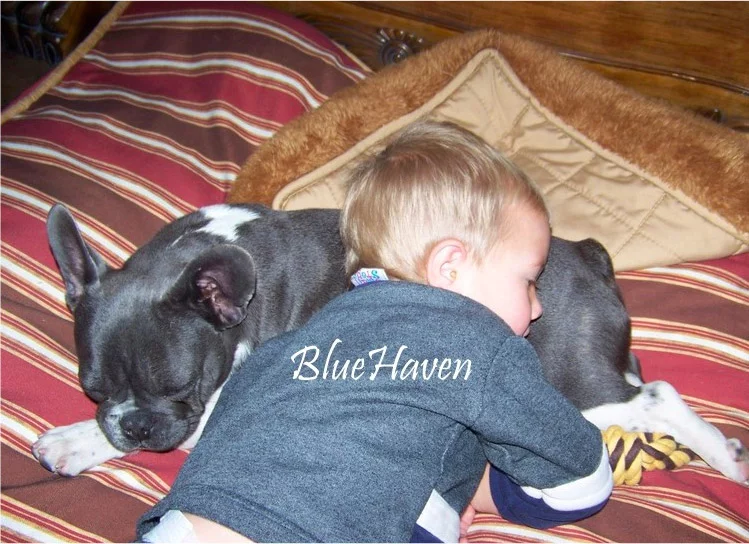

A Look Back...
According to history, lace-makers in 19th Century Nottingham, England selectively bred the early bulldog for a downsized or “toy” bulldog for use as a lap pet. When the Industrial Revolution displaced some of these lace-makers to France, they took some of these fun little dogs with them, and soon the toy bulldogs became very popular in France, hence their name the “French Bulldog”. They were particularly popular with ladies-of-the-evening, since these special little dogs were great conversation starters, and also because they were very content to lay quietly on the floor of a room for a few hours while business was being conducted. However, we don’t think this sordid background should be held against them :-).
These unusual and wonderful little dogs also caught the eyes of many wealthy Americans, who were doing the Grand Tour, so much so that many of these tourists brought a dog or two home with them. It was in America that selective breeding was done for the characteristic bat-ears. At this time in Europe, both bat-ears and rose-ears were prevalent. (We’re not really sure what rose-ears looked like – probably similar to the current English Bulldog’s floppy ears. We’re just glad the bat-ears became the standard because we think this is one of their most endearing features.)
After they were brought back to America, they continued to be known as the French Bulldog, even though the original breed was developed in England and much of the selective breeding was done in America.
Are French Bulldogs for everyone?
The AKC says that the French Bulldog should have the appearance of an active, intelligent, muscular dog of heavy bone, smooth coat, compact build, and medium to small structure, that is well proportioned. It’s expression is alert, curious, and interested. Even though all of our Frenchies fit this description well, all Frenchies, including ours, have a distinct look about them, even those of the same color or color pattern. If you’ve seen one Golden Retriever, for instance, you’ve seen them all. This is certainly not true with Frenchies, which make each one distinct and special.
French Bulldogs are fairly small – 28 pounds or less, so they can function as lap dogs (as ours do). They have a bully head which is large and square – generally being more pronounced in males than in females. Their two most noted features are (1) their characteristic bat-ears (which we just love) which are broad at the base, elongated, with round top, set high on the head but not too close together, and carried erect with the orifice to the front, and (2) their short tail which is either straight or screwed. In fact, no alterations are made to the pups what-so-ever, unless the dew claws are removed (but this is generally not done – and we don’t do it to our dogs unless specifically requested by a perspective owner who has made a non-refundable deposit, since it must be done during the first 5 days of life). Any other alterations are considered mutilations.
The neck is thick and well arched with loose skin at the throat. The body is short and well rounded. The chest is broad, deep, and full; well ribbed with the belly tucked up. The forelegs are short, stout, straight, muscular, and wide apart. The hind legs are strong and muscular and longer than the forelegs, so as to elevate the loins above the shoulders. In other words, these are solid little dogs which weigh more than they look like they should since they are so solid. We quickly learned this when we picked up our Frenchies; we have to grab them just behind the front legs – if you grab them in the middle they will tip forward, since they are so top-heavy.
The coat is moderately fine, brilliant, short, and smooth. The skin is soft and loose, especially at the head and shoulders, forming wrinkles. We just love to pet our Frenchies. They are soft and smooth and feel good to the touch, both for us and for our adorable dogs, based on their reactions. Since they have a fairly short, single coat, they do not tend to shed much. We are both fastidious housekeepers (like mother, like daughter) and if they were big shedders, believe us when we say that they would NOT be indoor pets at our house (which they are)!
One of the French Bulldog’s best features is that they come in such a variety of colors and patterns. In our breeding program, we specifically look for dogs with a variety of colors and color patterns, so that our puppies will come in a wide variety of colors and patterns, including the very beautiful and rare blues, chocolates, and lilacs, as well as pieds in each of the various colors. Piedness is a recessive characteristic in French Bulldogs but is still relatively common (two pied dogs will produce only pied puppies, a pied and a pied carrier will produce 50% pied puppies, two pied carriers will produce 25% pied puppies). A pied Frenchie is one that has a base coat of white with patches of a darker color (kind of like a Paint Pony). Fawns, sables, creams, and all brindles (dark coloring with lighter hairs mixed in, or the reverse) are all acceptable colors for AKC sanctioned events, but we also produce all of the gorgeous colors that are created from naturally occurring genes in the Frenchie gene pool (this does not include merles or long hairs, as these were probably created from genes introduced from other breeds). This includes fawn, pure coat (no brindling), and tan pointed puppies in black, blue, chocolate, and lilac.
In short, there are quite a variety of colors and patterns, which make them all so unique and special, even within the breed. Whatever your particular preference, we are producing what you are wanting.
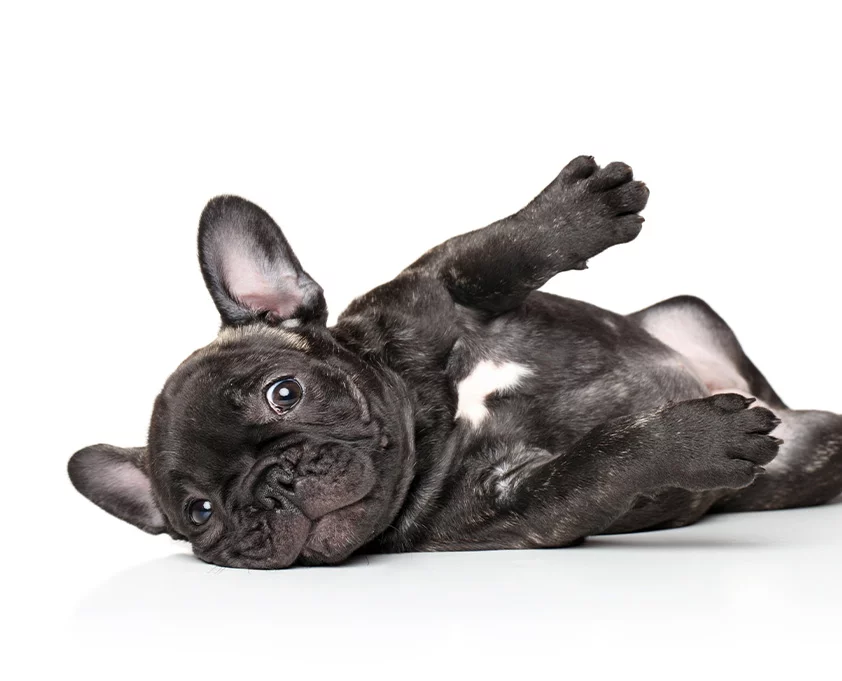

French Bulldogs are fairly small – 28 pounds or less, so they can function as lap dogs (as ours do). They have a bully head which is large and square – generally being more pronounced in males than in females.

The neck is thick and well arched with loose skin at the throat. The body is short and well rounded. The chest is broad, deep, and full; well ribbed with the belly tucked up. The forelegs are short, stout, straight, muscular, and wide apart.

The coat is moderately fine, brilliant, short, and smooth. The skin is soft and loose, especially at the head and shoulders, forming wrinkles. We just love to pet our Frenchies. They are soft and smooth and feel good to the touch, both for us and for our adorable dogs based on their reactions.

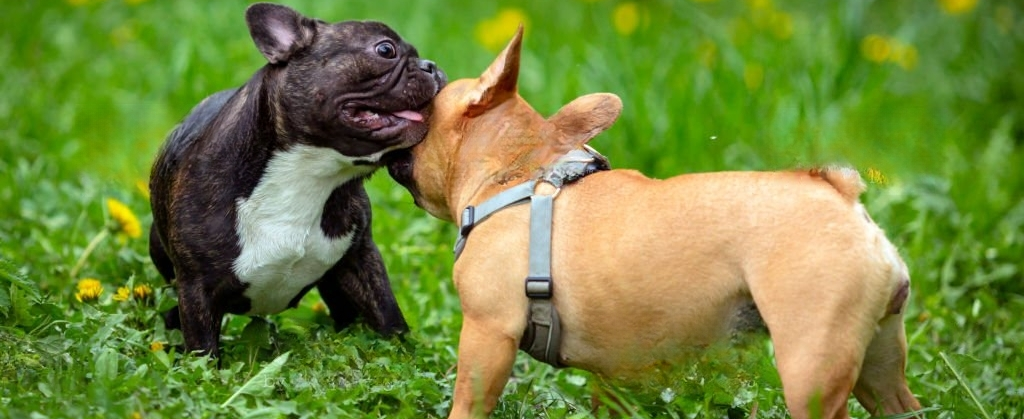
Temperament
The AKC describes the temperament of the French Bulldog as well behaved, adaptable, and comfortable companions with an affectionate nature and even disposition; generally active, alert, and playful, but not boisterous. We have certainly found this to be true with our Frenchies. Frenchies love people and crave attention, but don’t constantly demand it, like a Golden Retriever, for example. A French Bulldog will comfortably sit or lay at your feet, or in your lap if you prefer, or they will roll around with the little ones with great patience and never complain.
Since we have several Frenchies, we thought we might have a problem giving each of them sufficient attention, but it hasn’t been a problem. We can pet one of our Frenchies while others are laying in their favorite spots or playing with their canine buddies or with the kids. Our Frenchies don’t tend to get jealous as long as they get their turn.
Based on our experiences and from feedback from other owners, most Frenchies get along great with other dogs (of all sizes), especially if they have been well socialized, as have our dogs. In addition to our dogs, we have two cats, which are best friends with Django, Lacey’s house dog. When we have other Frenchies in the house, they quickly make friends with the cats and get along great. Many of our clients also have cats and we have yet to hear of any difficulties; in fact, several clients have told us that their Frenchie(s) and their cat(s) become the best of friends.
One of the most important factors in how well your Frenchie will get along with other animals is his or her age at the time you introduce them. The younger your Frenchie is when you introduce him or her to other animals, the better the chance that things will go well. Puppies love everyone and everything – also, older Frenchies accept new pups that are introduced to them extremely well, based on our experiences.
Fun Facts about Frenchies
If you are looking for a great companion dog with whom to share your home, that can provide you with more than a decade of dedicated love and affection, you’ve come to the right place. Your Frenchie should never be penned up for long stretches of time. He or she needs to be part of your life – they will insist on it. They love people and love to be around people all the time. Our Frenchies are not overly demanding of affection (like our Golden Retrievers used to be), but they want to be stroked and fussed over on a regular basis – some to a greater degree than others.
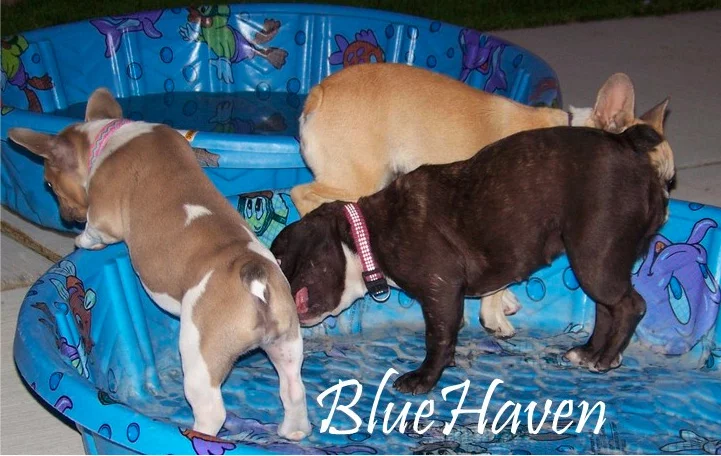
Barking
Even though Frenchies are not excessive barkers compared to other breeds (does excess barking drive you crazy like it does us?), they do make good watchdogs. They are alert and can become somewhat territorial and protective, which is what we want them to be. When we had Yorkies, you could count on loud barking anytime anyone entered a room with them, even those they loved the most. We haven’t found this to be true with our Frenchies. They only go on alert with people they do not know until they see from us that the intruders are no threat; and they do not bark unless something out of the ordinary occurs, for example, when someone comes to the door late at night. Even then, a quick “it’s OK” is all it takes to calm them down.
Grooming
Frenchies don’t require a lot of time or effort to groom, which we think is great; it gives us more time to snuggle or play with them! However, the loose folds on their faces should be kept clean and dry and their ears should be kept clean. Occasionally their nails will need to be clipped, but that’s about it. They do shed a little but they are short haired and single coated and shed less than most other breeds, so even if you’re a fastidious housekeeper, like we are, they are not a big problem.
Environment
Frenchies do very well in small homes or apartments and do not require a large yard in order to get necessary exercise. They only need a moderate amount of exercise which can be accomplished by a daily walk. In our case, our Frenchies get more than enough exercise just playing with each other and with the kids. We normally take them on walks or errands just to give them other socializing experiences and to show off our dogs, not because they need the exercise.
Bathroom
Frenchies have good bladders (at least ours do) and are not difficult to potty train, unlike other small house dogs we have had, like Yorkies or Shih Tzus (who loved to find a convenient spot on the carpet). For anyone in an apartment, those who just don’t want to go out in the cold, or for any other reason of convenience, we have found it very easy to train all of our Frenchies to use a pad. Puppies/dogs do not like to lie in their own feces or urine, and, if placed in the opposite end of their playpen from where their bedding is, it has been our experience that puppies pick up on it almost immediately (as long as the play pen is not too big). We were introduced to an amazing new product (Potty Training Puppy Apartment) that is basically a one bedroom, one bathroom home for your dog. It is a great way to potty train your Frenchie (it is basically the same concept that we use on all of our puppies) and they can use it as adults as well – providing a convenient place to use the restroom. To watch a video and find out more information on this product see “Great Products” and click on the drop down “Potty Training Puppy Apartment”.
Bed Sleeping
Not everyone wants to have a dog sleep in their bed with them; but, if you do, Frenchies make good bed partners. Even if they tend to make a few strange noises in the night, they tend to be sound sleepers and don’t mind sharing the covers. However, even if you plan on having your Frenchie sleep in your bed or in one of your kids’ beds, it is a good idea to crate-train them first; it certainly helps in house-breaking when they are young, as they will not want to soil their crate.
Training
Frenchies are moderately easy to train because they are so smart, although they can also be a bit stubborn and hardheaded, especially if you don’t work with them early on. If you make training a game, they’ll want to play all the time. Frenchies are considered people pleasers and love to be the center of attention. All of our Frenchies are a little different in temperament, just like people, but each of them loves to be shown attention. If you make your new Frenchie a part of your life, he or she will be a wonderful companion that you will enjoy immensely for many years to come.
Eating
Healthy Breed
Frenchies also tend to be a fairly healthy breed, which is a good thing with the kiddos chasing them around like they do. Because they are a short-faced (“brachycephalic”) and dwarf (“chondrodystrophic”) breed, they have some health concerns every owner should be aware of. Their short face makes their breathing less efficient, so Frenchies have less tolerance of heat, exercise, and stress, as has already been noted. Like other dwarf breeds, the stocky Frenchie occasionally has abnormal vertebrae. Because of the good musculature, problems generally do not occur, especially if the use of stairs and jumping is limited. While Frenchies occasionally have leg and joint problems, this small/medium size dog does not have anywhere near the knee joint problems which are so common in small breeds such as Yorkies, nor the hip problems so prevalent with large breeds such as Labs. In aggregate, this is a relatively healthy breed, especially considering it is both a flat-faced and a dwarf breed), and we have had overall good success with the health of our Frenchies and the puppies we have placed in great homes.
The Bottom Line...
As you can tell by now, we, along with the rest of the family, love the French Bulldog and will have them from now on, but no dog is perfect (or are they?). Other than what we have already mentioned above, you should also be aware of the following:
Frenchies can snore, and some do rather impressively, but so do the men in our house, so we hardly notice. They can also make some strange noises, especially when they are excited, but we think these noises are rather endearing and rarely notice. In reality, when they are in a calm state, they are a rather quiet dog.
Frenchies can also have occasional gas (OK, sometimes it’s more than occasional), especially if you feed them a dog food containing wheat, corn, or soy, which we strongly discourage. However, the men in the house say this is sometimes an advantage, in that one of the Frenchies can always be blamed (that’s assuming one is around).
Frenchies love people – all people, it seems. They will show a preference for their “owner”, but they are not above going to anyone willing to give them some attention. If you want your Frenchie to love you – and only you – you might be disappointed.
The bottom line is this; all things considered, the Frenchie is a fantastic companion pet, and if you are in the market for a companion dog you should give the French Bulldog serious consideration, if not one of our dogs, then one of someone else’s. These are very special dogs for very discriminating people and not everyone is a candidate to own one (or more). However, if you are the right kind of dog lover who is looking for a dedicated companion, one that not everyone else has, one that will elicit a lot of attention and will provide you with companionship, entertainment, and joy for a decade or more; the French Bulldog might just be the perfect dog for you!




